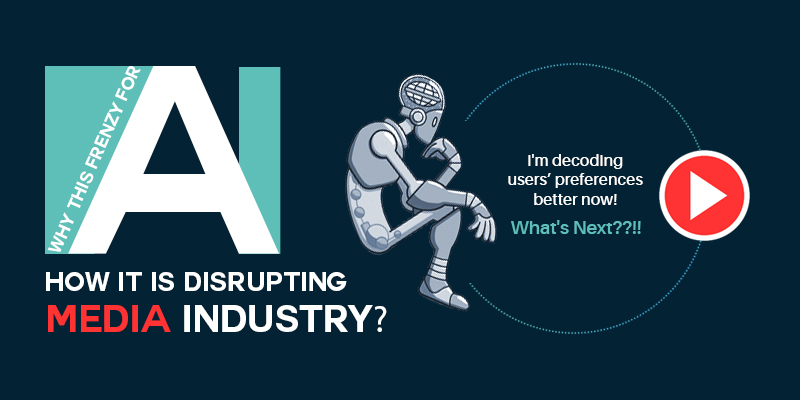WTF (Why This Frenzy) For AI. How It Is Disrupting Media Industry?

AI is all over the place, right from headlines to Tweets and not anymore reserved to Hollywood creations like ‘i Robot’, ‘Exmachina’ or ‘HER’. It is very much into your mobile apps and will be everywhere soon.
Why this AI frenzy? Well, it is not happening all of a sudden, instead it’s already in the scene for almost a couple of years. Stalwarts like Google, Apple, Facebook, Twitter and Intel are into the AI race. Here is a bit of number crunching.
- Google’s parent Alphabet – 11 AI startups
- Apple – 7 AI startups
- Facebook – 5 AI startups
- Intel – 5 AI startups
- Twitter – 4 AI startups
The surreal acquiring-spree of AI startups by technology giants clearly hints a technology shift in several industries and media is proving to be one of the early adopters.
Pioneers In Media Leading The Way In AI Adoption
“We’re at the very beginning of a 20-year megatrend,” – Tod Loofbourrow, former artificial intelligence instructor at Harvard.
The Netflix And AI Story – Trivia Since 2014
The desperation for innovation in Netflix’s recommendation engine is what which paved way for AI technology investment by the VOD giant.
Deep Learning: With Deep Learning, Netflix started decoding the preference patterns of users to provide better recommendations that users are more likely to watch. The recommendation algorithm has evolved to a stage where it can now match tiles to the exact people who would be interested in them which saves $ 1 Billion per year. Whopping figure right?
Region-based approach: A revamp of the recommendation engine helped in providing a region-based approach to personalized suggestions as Netflix probed into new markets as a part of its massive expansion.
Dynamic Optimizer: The latest of all is the Dynamic Optimizer revealed at MWC by Todd Yellin, Vice President of Innovation at Netflix.
The Dynamic Optimizer extends the reach of AI innovation from product recommendation to technical perfections. According this recent improvement, Netflix will be able to work on video codecs that will enable it to achieve quality video streaming and reduced buffering even for slow mobile data connections.
This development is believed to achieve a significant level of user satisfaction especially in markets like Japan, Korea and India where Netflix is expecting steep increase in usage of mobile video viewership.
The roadmap: With AI backing, Netflix is amassing information from millions of users which constantly improves its capabilities in video recommendations and with technological improvements like quality video rendering for low data connections, the brand is poised to set benchmarks for user satisfaction in global markets.
YouTube – From ‘Collaborative’ Filtering To AI
YouTube is one of the most sought after free video content providers and a catalyst in creating mobile video viewership globally.
Collaborative Filtering: It all started off with what is called ‘Collaborative Filtering’ back then when YouTube first tried to improve its recommendations to viewers. It was based on deciphering videos to be recommended based on the liking of a group or a number of users.
Neural Networks: Now it is AI taking the lead in full flow. YouTube’s AI is backed by neural networks which is basically an algorithm that simulates the human brain in looking for video contents. These simulations help in taking more refined decisions that are more likely to resonate with the preference of users.
YouTube’s data processing capabilities have helped in achieving this. With billions of user behavioral data pouring in from several regions and devices, the algorithm is able to process much deeper patterns instead of just scratching the surface and evolve into complex forms of machine learning.
User Satisfaction: Through AI, YouTube has figured out video content preferences and is already gearing up to address its next big challenge ‘User Satisfaction’.
Recommending contents that people would love to watch is the agenda than providing them with suggestions they usually watch.
To close in the thin line, the VOD giant is conducting surveys with users to know deeper on individual videos. These data will then be fed into AI algorithms and with more exposure to data, YouTube would actually become more fine-tuned.
Applications Of AI In Media
Audience Profiling And Trailer Cuts
Apart from customer support, AI has started proving useful in various other departments. AI, based on the data provided in terms of user engagement, develops ideas on the more likely scenes, clippings that audience love. By knowing audience preferences through AI, on demand video providers can create video contents that they love and create audience base for new shows.
Movie makers are toying with the idea of getting AI to cut trailers for movies which are more likely to be liked by audience. Experts say that AI based trailers are proving to be more engaging and it takes less time to create one.
Image recognition for visual recommendations, speech recognition, language processing for better user understanding and deep learning are helping AI contribute far more than just customer support.
Accuracy In Ad Targeting
Advertising is becoming more precise. Mixing up AI with analytics, Big Data, machine learning and more, the product preferences of audience can be deciphered better. Ad targeting is getting smarter as viewers tend to get the ads of products they love, or already abandoned or in their wish list in between videos which will increase chances of conversions.
Additionally, for a video on demand website or app, the benefit of providing relevant ads in between videos will make audience feel a highly personalized treatment right from video viewing to up selling.
Automating Content Creation
Though AI cannot come up with emotional responses, it can create contents based on facts and data observed.
Commentary for sports events, weather news based on reports, survey reports for financial firms or stock markets and more. Though AI is in its nascent stages in terms of content creation, with continuous innovation, AI can be used to create content like reviews based on user opinions, product descriptions and so on.
Real-Time Technical Intelligence
The machine learning capability can being used to find out technical issues across thousands of touch points. What if, a video streaming company is able to detect video start failures and buffering issues across multiple touch points.
Brands like ESPN, HBO, SKY, NBC Sports and BBC are already leveraging on AI-powered analytics like Conviva to render flawless streaming across all devices.
These AI-algorithms can not only locate technical issues but also provide the intelligence that can diagnose origin of technical glitches. Thus AI-backed alerting tools are a boon to video streaming brands which helps them to be proactive in coming up with fixes. In scenarios like live broadcast, AI algorithms can help brands fix issues even before an user becomes aware of it.
Summing Things Up:
“The $300-350 million spending for AI in 2015 is projected to be $30 billion by 2025” – Forbes
AI is the future and the frontrunners in the media industry are already into it. The very recent future will show signs of AI improving in providing marketers with intelligence to user moods and automating content creation.
With more data, AI can evolve better. Tracking user data is crucial for your business to create an AI that can foresee opportunities for improvement and evolve as a brand that customers love.


